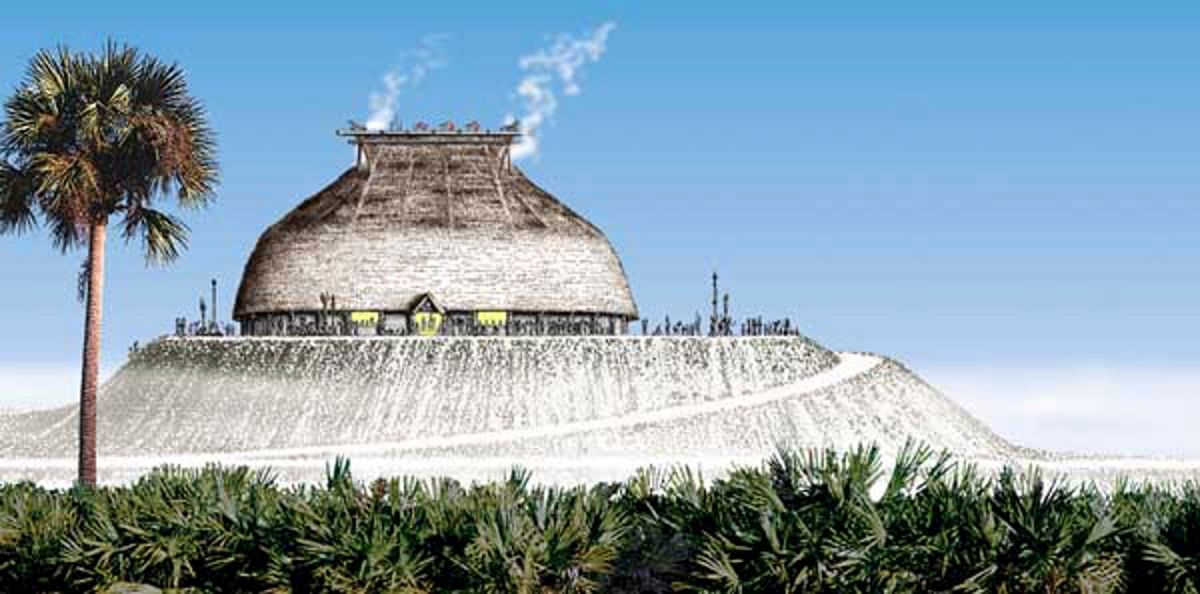The Calusa who so fiercely battled Ponce de Leon were a remarkably complex hunter-gather society that had reached its zenith at the time of his contact. They dominated almost all of southern Florida, collecting tribute from towns that were far distant from their coastal homeland.
When the Spanish arrived there were probably 20, 000 Calusa living in 50 villages. At their capital, Mound Key, they had constructed an expansive manor on top of a massive 30-foot-high shell mound that could hold 2,000 people. Rituals were performed in a special temple with benches and a central altar, with walls covered with masks.
The Calusa built canals between the major coastal towns and inland waterways to facilitate movement and trade. Intricate weirs were built of rocks and shells to capture and store fish. They used a wide array of canoes, including seagoing vessels. small cargo carriers and larger barges with platforms connecting two canoes.
The Calusa were a sedentary people and depended primarily on estuarine fish and shellfish for food. Hernando d’Escalente Fontaneda, a Spanish castaway among the Calusa from 1549 to 1566, described all the Indigenous people of southern Florida as “great anglers [who] at no time lack fresh f The fact that the Calusa were fishers, not farmers, would perplex the Spaniards, who were used to interacting with Indigenous farmers who could provide them with food” (Reilly, 1981)
While they lacked agriculture, Calusa had one of the most complex political societies in North America. As described by Marquardt (2004): “The paramount leader (or cacique), a war captain, and a head priest were the three primary political leaders. The paramount leader sat on a special stool and was greeted with deference He and his sons were fanned with incense by the chief priest. A significant part of the paramount’s authority rested on his ability to mediate between the secular and sacred realms … The nobility, military, royal family, and other specialists extracted surplus from the commoners. Town leaders sent tribute to the paramount, who sometimes redistributed it. Outside the immediate Calusa domain, other polity chiefs paid tribute to the Calusa paramount, and each provided him a wife … The captain-general, or war captain, waged war on behalf of the Calusa and commanded military specialists and a militia that could be mobilized at the request of the paramount. Subjects in all the towns under the control of the paramount could be commanded to manufacture weapons to meet a threat.” All the leaders were close relatives of the king and leadership was based on descent from the ancient founders of their society.
The Calusa averaged about 4” taller than the Spanish. The men allowed their hair to fall to their waist and wore only a leather breechcloth. The women wore skirts woven from Spanish Moss and palmetto leaves. The common people wore very few personal adornments.
The Calusa were outstanding craftsmen. Their art, with their carved wooden painted wooden masks, was “without known parallel in America” (Reilly, 1981). They produced an extensive inventory of skillfully made artifacts including awls, chisels, knives, hammers, scrapers, gouges, dippers, spoons, beads, pendants, picks, weights, and celt belts made from shells. The Calusa did not make any items from pottery. Shells were used to make items like jewelry, utensils, and tools. They used a shark’s tooth knife to produce beautiful and sophisticated art, including tubs, bowls, mortars, pestles, amulets, and tablets. They produced some of the most renowned pieces of Amerindian artwork in the form of feline sculpture. They made technologically challenging, artistic pottery using imported clay for at least 2,000 years and learned how to hammer and emboss the gold, silver, and copper from the numerous Spanish shipwrecks along the coast. They also used local fibers to produce excellent cordage, rope, and netting.
In the Calusa religion, a sun deity was the universal creator and they believed that three supernatural beings ruled the universe. The most powerful deity was Toya, who governed the physical world, the second most powerful deity guided government leaders, while the third ruling deity influenced the outcome of battles, choosing the victor in advance.
The Calusa thought that humans had three souls – the pupil of a person’s eye, his shadow, and his reflection. The soul in the eye pupil remained with the body after death, while the other two souls left the body after death and entered into an animal. If a Calusa killed this animal, the soul would migrate to a lesser animal. Repeated killing of animals, containing human souls would eventually reduce the third soul to non-existence.
Human sacrifice was a common practice. When the child of a cacique died, all households were required to bring one of their children to be sacrificed. When the cacique himself died, his servants were sacrificed to join him. Each year a Christian was sacrificed to appease the Calusa idols.
Illustration: The Calusa constructed an expansive manor capable of holding 2,000 people atop a 30-foot-high shell mound. Florida museum illustration by Merald Clark.
Bibiography:
Marquardt, W. R (2004) Calusa. In: Handbook of North American Indians, Volume 14: Southeast, R. D. Fogelson (ed.), pp. 204-212. Smithsonian Institution: Washington.
Reilly, S. E. (1981) A Marriage of Expedience: The Calusa Indians and Their Relations with Pedro Menéndez De Avilés in Southwest Florida, 1566-1569. The Florida Historical Quarterly 59 (4): 395-421
Ricky, D. B. (1998) The Encyclopedia of Florida Indians: Tribes, Nations and People of the Woodland Area. Somerset Publishers, Inc.
Worth, J. (1995). Fontaneda revisited: Five descriptions of sixteenth-century Florida. The Florida Historical Quarterly, 73 (3): 339-352.
